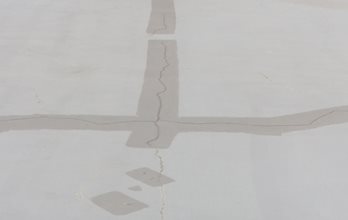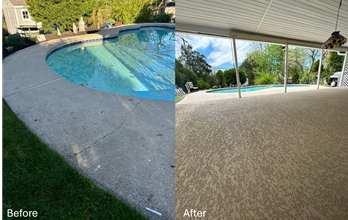Concrete Crack Repair in the Philadelphia Metro Area
Learn how to approach repairing cracks in concrete surfaces like patios, driveways, pool decks, and more.
Concrete is strong and durable, but it can still crack. Fortunately, you don’t need to tear out your entire concrete slab when this happens. In most cases, repairing and/or resurfacing your concrete is the better option.
Get a free quoteWHY CONCRETE CRACKS
Concrete can crack for various reasons. If the concrete wasn’t mixed properly or control joints weren’t installed correctly, cracks will show up later. But even concrete that was installed perfectly can crack eventually. While it can withstand heavy loads, it doesn’t have a lot of resistance to bending or stretching. Freeze-thaw cycles can also contribute to cracking.
Learn more about our concrete repair services.
CONCRETE CRACKS: TYPES
Different types of cracks require different approaches when it comes to repair. Before you repair a crack, it’s important to determine what’s causing it and how severe it is. Here are common types of cracks and how they should be addressed.
Hairline cracks
Caused by natural shrinkage as concrete cures, these types of cracks don’t indicate structural issues. They do need to be repaired to prevent moisture from seeping in.
Solution: Fill with crack filler or adhesive.
Shrinkage cracks
These cracks are wider than hairline cracks and appear in random patterns.. They tend to form when the concrete dries too quickly or when too much water is used in the mix.
Solution: Fill with crack filler or adhesive to prevent them from getting bigger. In some cases when shrinkage cracks are significant, resurfacing may be required.
Settlement cracks
These types of cracks sometimes show up when the ground beneath the concrete isn’t compacted enough. It can also happen if a heavy load is applied to the surface before the concrete fully cures. When you see settlement cracks, you may also see unevenness in the slab.
Solution: Grinding and sealing can sometimes resolve these, though more serious cases need to be resurfaced or replaced.
Structural cracks
These are the most serious types of cracks because they are wider and deeper than other types. Structural cracks are often caused by poor reinforcement in the slab, or shifting foundations.
Solution: In some cases, replacing the slab may be the best long-term solution.
WHAT IS CAUSING YOUR CONCRETE TO CRACK?
Before repairing, it’s important to figure out what’s causing your concrete to crack so you can prevent future cracking.
The cause could be environmental (e.g., moisture or freeze-thaw cycles), outside disturbances (e.g., tree roots growing under the slab), or poor installation. If your surface is cracking because of poor reinforcement, you’ll probably need more than just a surface repair. A professional contractor can assess the damage and suggest the best solution.
 SUNDEK of PA resurfaced this patio and pool deck in King of Prussia using Classic Texture in Kalua, incorporating the Custom Scoreline Effect.
SUNDEK of PA resurfaced this patio and pool deck in King of Prussia using Classic Texture in Kalua, incorporating the Custom Scoreline Effect.REPAIRING CRACKED CONCRETE: WHAT ARE THE OPTIONS?
Here are a few techniques our contractors use to repair cracked concrete:
- Custom Scoreline Effect: This method, which was developed by SUNDEK, uses existing cracks in the design of the surface, then uses them as functional expansion joints.
- Repair the crack: If you decide to repair each crack individually, you may want to eventually resurface the entire slab so it has a uniform look.
- Remove and replace: If cracking is severe, repair might not be a good long-term solution. If you’re unsure, ask a professional to assess your surface and let you know the best approach.
RESURFACING: THE SUSTAINABLE OPTION
If your surface is still in good condition, structurally, resurfacing is a far superior option than tearing concrete out and replacing it. In addition to being easier on you (skip the headache of a demo job and having to dispose of all the old concrete), it’s also much more environmentally friendly. Resurfacing allows you to use the slab you have and give it a brad-new look.
COST OF CONCRETE CRACK REPAIR
Using inexpensive crack fillers is sufficient for repairing small hairline cracks. More extensive damage needs much more, though. Consult a professional contractor such as SUNDEK of Pennsylvania for guidance on what the best approach is for your surface. We can assess the extent of the damage and provide you with options.
IS CONCRETE CRACK REPAIR SOMETHING I CAN DO MYSELF?
While minor cracks are approachable for people who’d like to do it themselves, it’s very important that you do sufficient research and use good products so the repair lasts. When incorrectly done, the crack can return or even get worse. Hiring an experienced contractor ensures a proper and durable repair.
Contractors who repair cracked concrete near me
If you’re looking for a contractor who can repair your cracked concrete we’d love to help!
At SUNDEK of PA, we’ve been installing high-quality concrete coatings for clients in Philadelphia, Doylestown, West Chester, Harrisburg, Lancaster, York, and the surrounding areas for more than two decades.
Call us: (888) 491-2200
Email us: [email protected]